Our Wild Africa Trek at Disney’s Animal Kingdom continues…
When we left you, nick had successfully crossed the bridges and all 12 trekkers had made it to our private savannah tour vehicle. (Crossing the bridges post is here) The tour vehicle is much smaller than the big trucks used on the Kilimanjaro Safari. Our truck had a roof with roll up curtains (the Wild Africa Trek goes rain or shine) but there are no spotting guides for you with pictures of the animals like there are in the regular Kilimanjaro Safari trucks. A suggestion: maybe provide laminated guides to the safari animals? Truck had padded benches that wrap around the inside, these were wide enough and the truck was roomy enough so that you can easily spin around and look “behind you.” These benches are much more comfortable than the hard benches on the Kilimanjaro Safari trucks. There were decent binoculars provided for the trekkers (us). Again, unlike the Kilimanjaro Safari, we were not forced to stay in our seats, we could get up and move from side to side or front to back (mostly while the truck was not moving, and thankfully all of us trekkers were considerate of each others’ desires to “see it too”). The guides only cautioned us when the truck was moving and we were near the back of the vehicle where there is no bench.
We were a bit concerned how many animals we would see. All the animals on the savannah roam freely. It has been our custom to always do the safari first thing in the morning. We have always heard that the animals are most active early in the day. This is also when all the food is put out near the regular safari tour so the animals are more likely to be eating. But we learned that the Wild Africa Trek can stop on the savannah and has time to “wait” for the animals that roam around to appear and come nearer.
You enter the savannah along the same path as the regular safari trucks. There were no animals near the first part of the path so the guides starting talking about the termite mounds. As we turned to the right, we spotted two wildebeest grazing behind one of the smaller termite mounds. One is only visible because his back sticks up out of the grasses. There is also what we think is a small gazelle grazing behind the wildebeest in the foreground. We didn’t spot the gazelle until nick edited the photos!
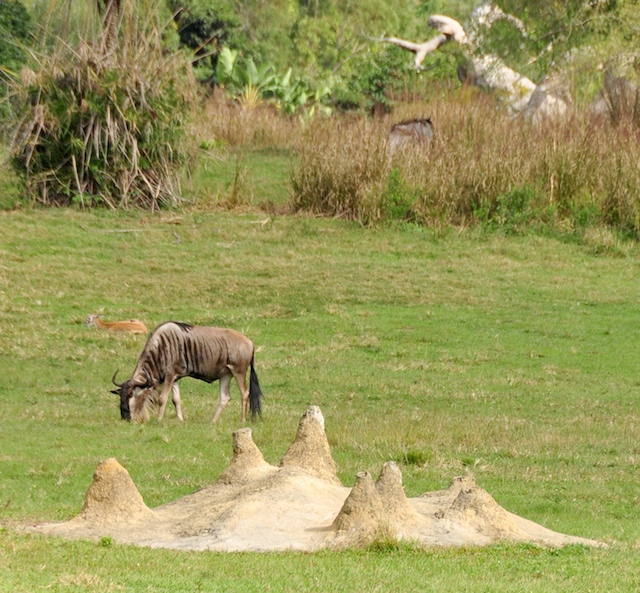
The wildebeest in the foreground is easy to spot. Can you find the other one?
Some Ankole cattle were out but heading away from us so we kept moving. Did you know that they’re also called “Watusi” cattle? They get that name because they’re domesticated by the Watusi tribe in Africa. They aren’t used for meat or milk, instead they’re status symbols and wealth.
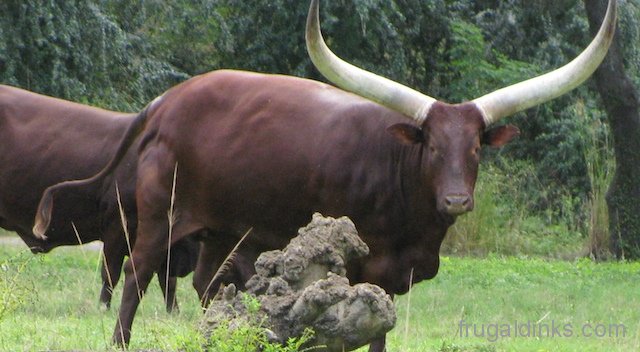
These cattle pump blood up through those large horns to cool themselves down.
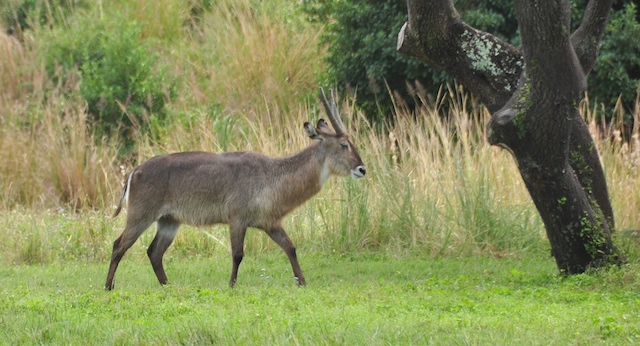
As soon as nick snapped that photo, he turned and saw a Sable Antelope.
Fortunately since the savannah was pretty quiet (few animals to see), we pulled off the main road and stopped. This is MUCH better than the regular safari! It was pleasant just to have the quiet and to be looking for animals. Soon off in the distance we see giraffes!
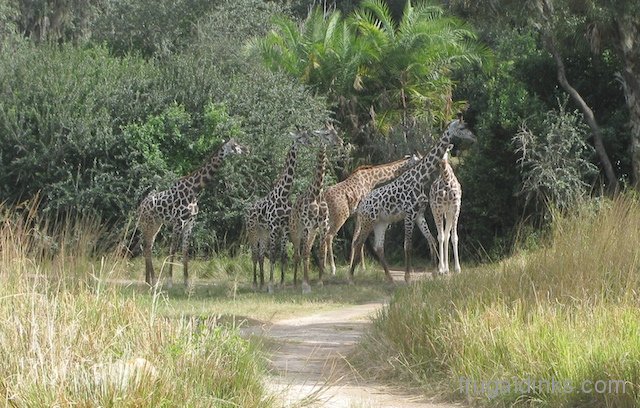
What do you call a group of giraffes? A tower.
We had always been told whenever we saw a giraffe on the regular safari that they are reticulated giraffes. The name “reticulated” comes from the appearance of their hides, the hides look like pale netting has been thrown over a darker tan background. If you look closely at the photo above, you’ll see that the giraffes do not all look the same. There are actually two kinds of giraffes living on the savannah at Animal Kingdom. There are Reticulated Giraffes and Masai Giraffes on the Kilimanjaro Safari. If we’re remembering correctly, the giraffe on the far right and the one in center rear, both with the very pale colored legs and hides (in comparison to the other giraffes) are Masai giraffes. The change in lower leg coloration and lighter hides were the only distinguishing features WE could see. (Again, we had no way to take notes so we are working from memory – need to do this tour again!)
K2 were both busy with the binoculars. I think they both enjoyed getting time to have an “up close” look.
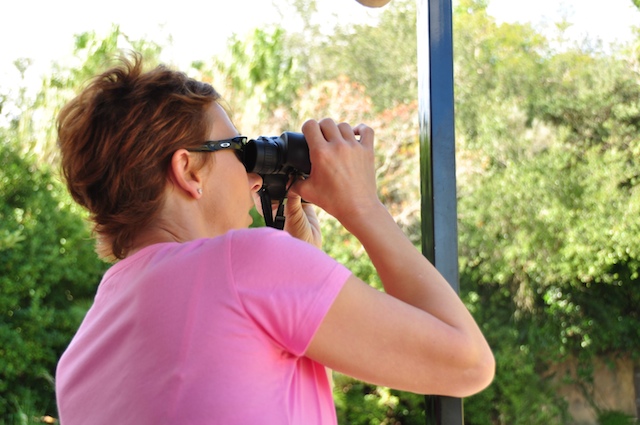
K2 were both busy with the binoculars, we think they both enjoyed getting time to have an “up close” look.
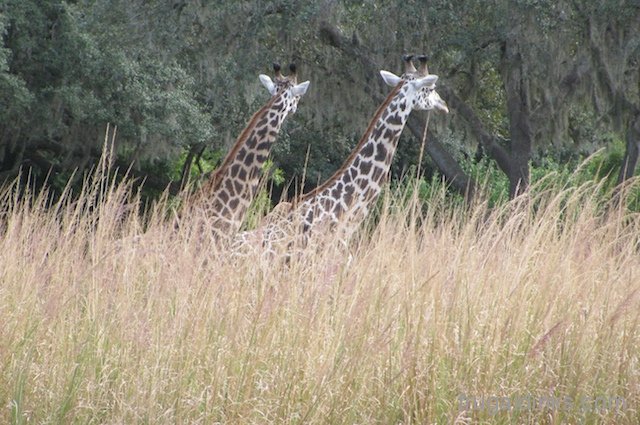
Soon a couple more giraffes were crossing the savannah.
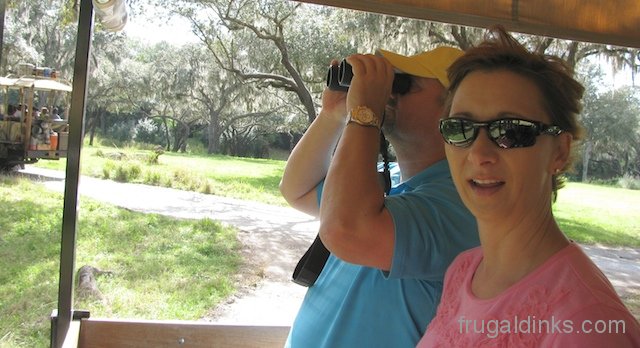
K2 may be thinking, “Will they come closer?” Our hopes are up as a few of the giraffes started heading toward our safari vehicle.
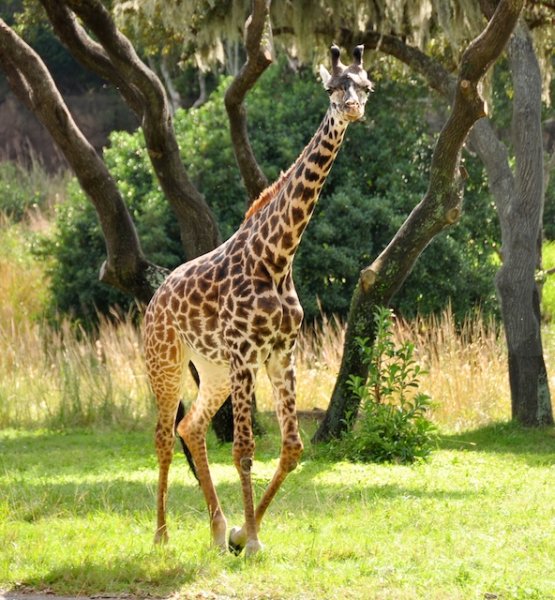
Here comes a giraffe!
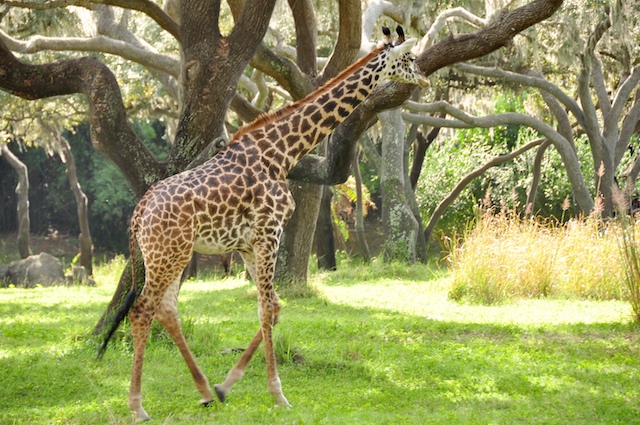
And… another one…
This is why you spend extra money to do special events at Disney. In this case, on the regular safari you cannot stop (unless an animal crosses directly in front of the truck). But, on the Wild Africa Trek we parked and waited for things to happen. And a lot happens when you can wait and watch. Our two guides were great, shooting photos and giving us detailed information (wish we could recall everything they told us).
Soon our guide Chris was excited. He told us all to look at how a giraffe gets its head to the ground. We were being treated to something you will probably never see on the regular safari. Look at how far the legs must splay out to get that long neck over far enough for the head to reach the ground.
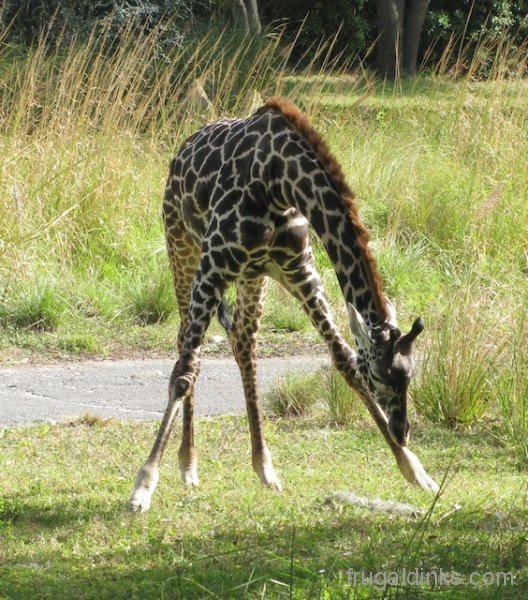
Whoa, not an easy thing to reach the ground with those long legs and long neck.
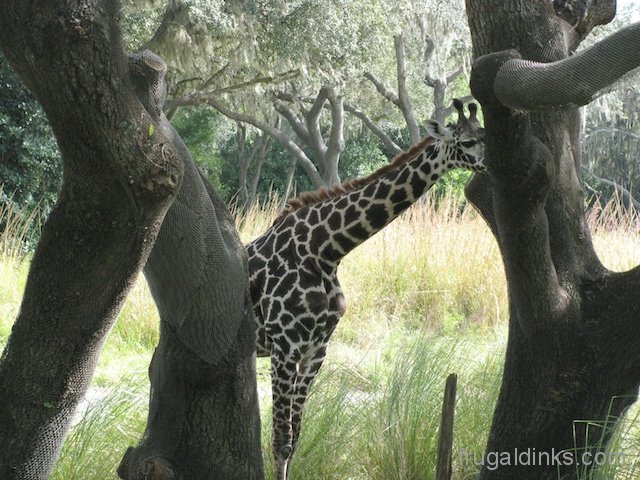
As soon as nick snapped the above photo he glanced to the right to see a giraffe eating from one of the hidden feeders.
If you look closely, you can see metal mesh wrapping around the trees. Nora remembers that the guides told us that many of the grazing animals on the savannah, including the giraffes, like to eat the bark of the trees. The Imagineers have wrapped them in mesh so that the animals don’t inadvertently destroy the fauna on the savannah.
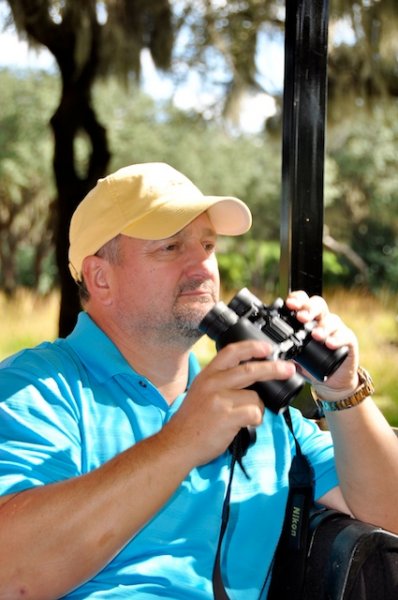
Okay that was all fun but time to move on, I want to spot more animals.
We drove slowly along the safari path while our guide Chris continued to tell us about what we were seeing. On the Wild Africa Trek, you can move slowly thus we had to pull over a couple of times to let the regular safari trucks pass (they fly through the savannah). Again, a great plus – even when there was no place to park, we just pulled over and let other vehicles pass. This allowed us to get all the info Chris had to offer on a particular animal or even plant.
Soon we were at the Elephant habitat. Unfortunately the elephants do not roam freely. We didn’t ask why, but suspect it’s because they eat so much and are so territorial that it would be hard for them to coexist with the other species on the savannah. Animal Kingdom has set up a parking spot for the Wild Africa Trek just across from the elephant’s habitat.
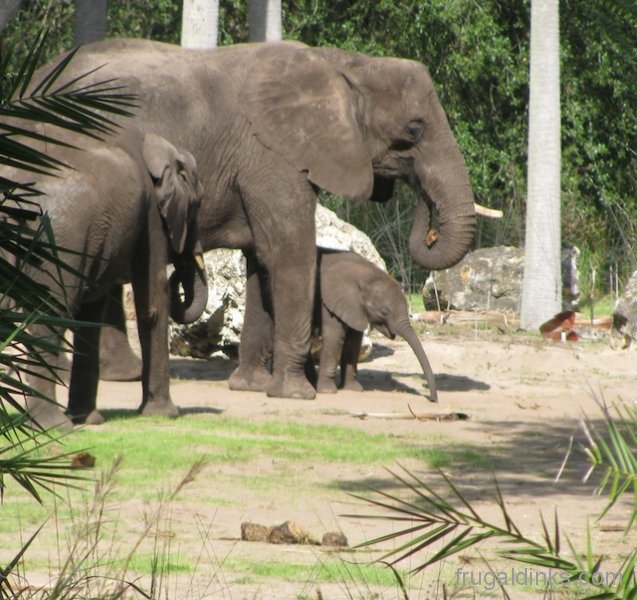
Yes, in the above photo is the newest addition to Disney’s elephant herd. The breeding program at Animal Kingdom has been very successful. The first baby elephant, a male named Tufani (a Swahili word meaning “storm”), was born in 2003 – he was the 4th surviving elephant born in North America conceived by artificial insemination. Kianga, a female whose name means “Sunshine” in Swahili, was born the following year. A second female, Nadirah (Swahili for “precious/rare/gift”) was born in December of 2005. In 2008, a new baby male, Tsavo joined the herd (according to Wikipedia, “Tsavo” is a KiKamba word meaning “place of slaughter,” perhaps as the second male to join the herd he was given a strong, warrior-like name). In 2010, Luna (female, name meaning “moon”) was born at Animal Kingdom. And in June of this year, the newest baby (seen above) joined the herd; her name is Kianga and her mother is also Tufani’s mother, Moyo. Since this was Moyo’s second calf, Kianga has amazed everyone at Animal Kingdom with how quickly she’s assimilated into the herd. She has even entered the water already, something that’s amazing because elephants are born knowing “NOTHING,” their mothers and the rest of the herd have to teach them everything.
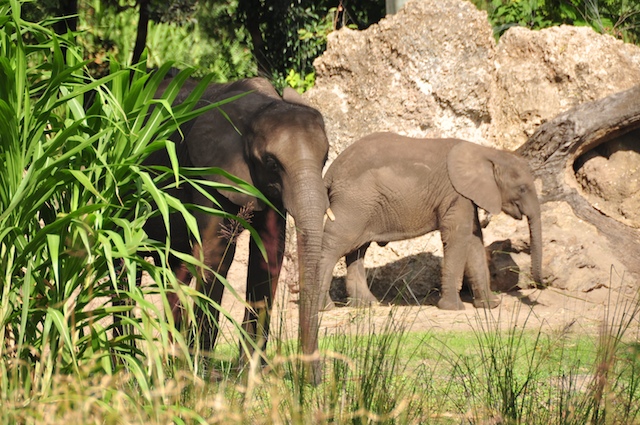
There were several juveniles and young elephants out and about. What a lovely tribute to the successful breeding program.
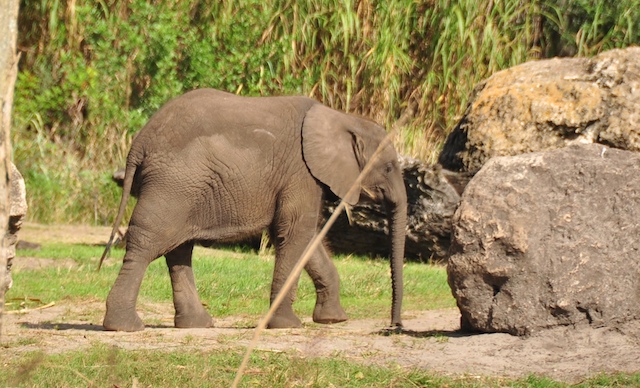
Another juvenile
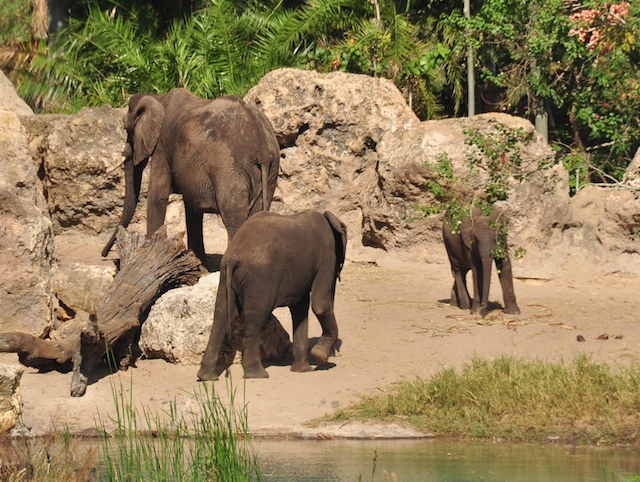
Elephant family leaving the water.
We spent less time observing the elephants. However, we didn’t spend too little time here. There was less to see than on the savannah with the variety of animals. Plus we were going spend quite a while on the savannah and we had lunch plans! As we drove over to the safari camp for our lunch there were more things to see and Chris, our guide, let us know what we were looking at…
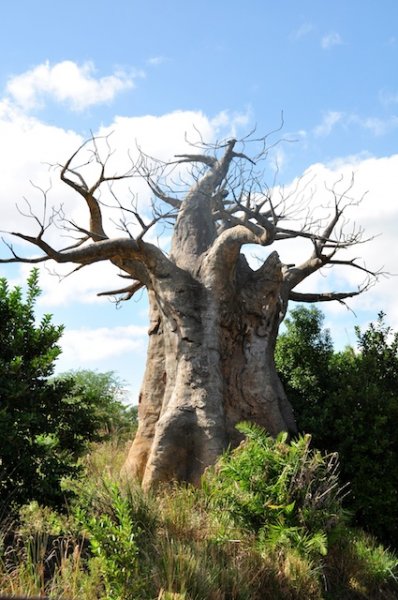
We passed the baobab tree (upside down tree), this has become a symbol for Kilimanjaro Safaris at Disney’s Animal Kingdom.
Next up were the pink flamingos. The photo is not great but you may be able to see that some are nearly white instead of pink. The white and grey flamingos are not yet adult so their feathers have not taken on the pink that comes from their diet and age.
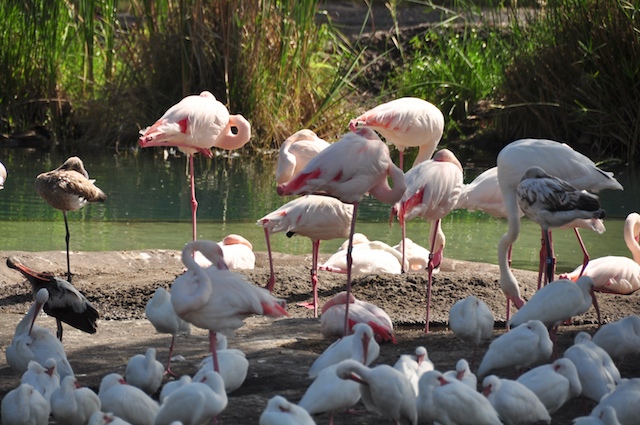
Flamingos hanging out in their pond near the elephants.
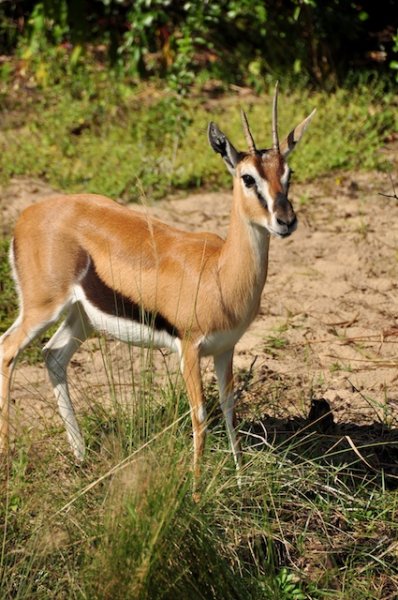
Around the next bend we saw a Thompson Gazelle (a.k.a. “Tommie”); these look like juveniles but they’re full grown, just tiny.
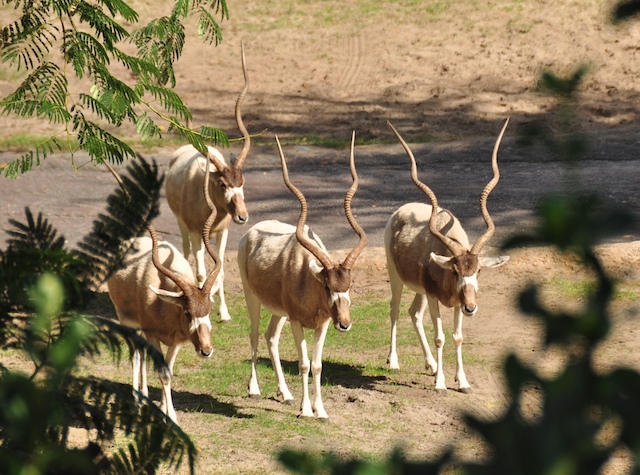
As we neared the safari camp, we saw some Kudu. The truck was moving very slowly and they didn’t seem at all bothered by our presence.
At this point we are about 2 hours into our 3 hour trek. We have crossed bridges, got up close with hippos and crocodiles, spent some leisurely time sitting on the savannah animal spotting and got to watch the elephants for a bit. Although we had some concerns about this trek, so far we were quite impressed.
Tomorrow we’ll post about the last hour and especially our time at the safari camp. Just a teaser, this was fantastic and we had a few surprises. If Animal Kingdom ever offers a special meal at the safari camp, we hope that we can find a way to get in! See you tomorrow…
nora & nick
You must be logged in to post a comment.